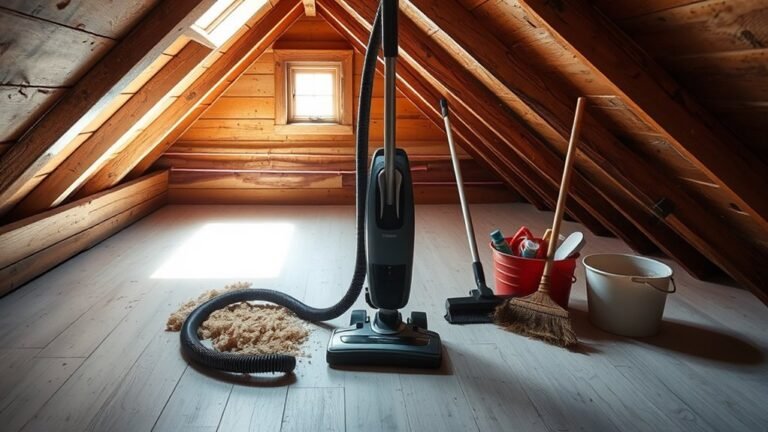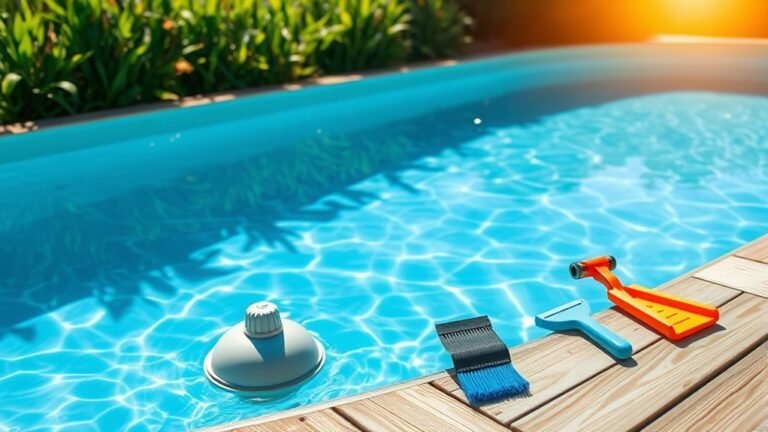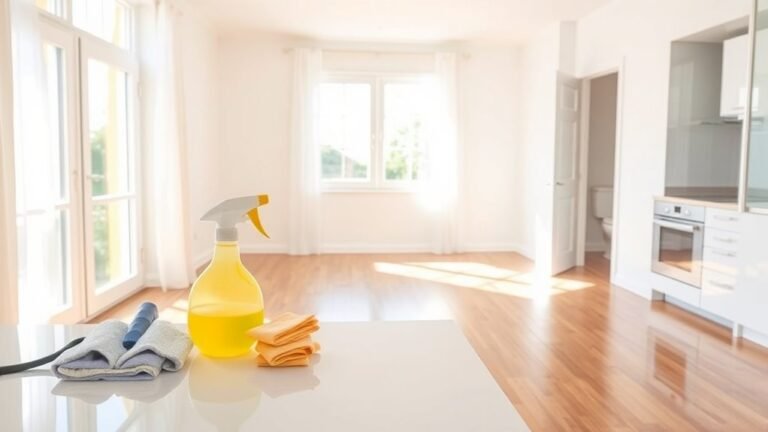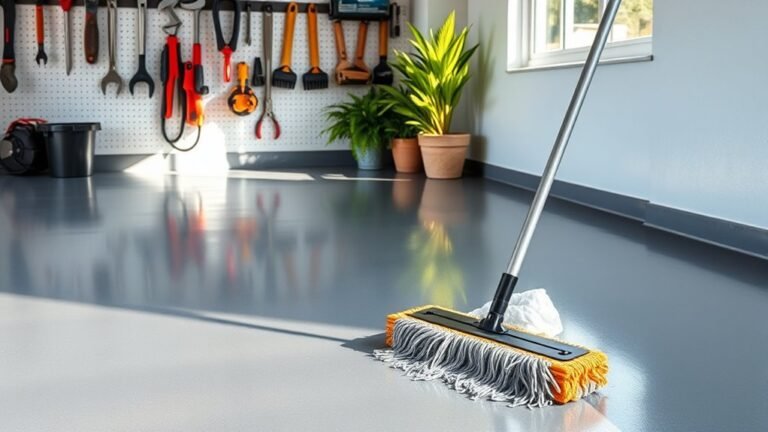Common Mistakes When Cleaning Balcony
When cleaning your balcony, avoid using harsh chemicals that can damage surfaces and don’t skip safety gear like gloves or non-slip shoes. Always sweep before mopping to prevent spreading dirt, and be careful not to overwater plants. Avoid abrasive tools and high-pressure water on delicate materials, and make certain drainage is clear to prevent water buildup. Skipping regular maintenance and rushing drying can lead to mold or damage. Keep these points in mind, and you’ll find smarter ways to protect your outdoor space.
Using Harsh Chemicals That Damage Surfaces

Although it might seem like a quick fix, using harsh chemicals can actually damage your balcony’s surfaces. These substances often eat away at paint, corrode metal, and degrade wood, reducing your balcony’s lifespan and aesthetic appeal. Instead, consider chemical alternatives that provide effective cleaning without risking surface protection. Natural solutions like vinegar, baking soda, or mild detergent mixtures allow you to maintain a clean space without harsh side effects. By choosing gentler options, you preserve your balcony’s integrity and avoid costly repairs. Prioritizing surface protection means you can enjoy your outdoor area longer and with fewer worries. Remember, freedom in maintaining your space comes from smart choices that balance cleanliness and care. Avoid harsh chemicals; opt for safer alternatives every time. Using eco-friendly materials not only protects your balcony but also benefits the environment.
Ignoring Safety Measures While Cleaning
Choosing safer cleaning agents is just one part of maintaining your balcony—overlooking safety measures while cleaning can lead to accidents or injuries. You want to enjoy your outdoor space freely, but ignoring safety gear and fall prevention can quickly turn a simple task into a dangerous situation. Here’s what you shouldn’t skip:
Choosing safe cleaning agents is essential, but never neglect safety gear and fall prevention to avoid accidents.
- Always wear proper safety gear like gloves and non-slip shoes to protect yourself from chemicals and slips.
- Use sturdy ladders or platforms with secure footing to avoid falls when reaching high spots.
- Keep the balcony clutter-free during cleaning to prevent tripping hazards that compromise your balance and safety.
- Developing a regular cleaning schedule helps maintain safety and cleanliness over time.
Neglecting to Sweep Before Mopping

If you skip sweeping before mopping, dirt and debris will just smear across your balcony floor, making the cleaning effort ineffective. Proper sweeping techniques remove loose particles that would otherwise create streaks or stains when wet. Start by using a broom suited for your balcony’s surface, sweeping in one direction to gather debris efficiently. Once the area is clear, apply mopping methods that complement the clean surface, using minimal water to avoid puddles and slips. Skipping this step not only wastes your time but also reduces the lifespan of your flooring. By combining effective sweeping techniques with appropriate mopping methods, you maintain a spotless balcony floor effortlessly, freeing you to enjoy your outdoor space without hassle or frustration. Choosing the right broom type, such as an angled broom, can greatly improve the effectiveness of your sweeping.
Overwatering Plants During Cleaning
When you’re cleaning your balcony, it’s easy to overwater your plants by accident, especially if you’re rinsing surfaces nearby. Overwatering effects can quickly compromise plant health, leading to root rot and fungal diseases. To protect your green friends, keep these points in mind:
- Control water flow: Don’t direct a high-pressure stream toward your pots; gentle rinsing prevents waterlogging.
- Monitor soil moisture: Check your plants before watering—if the soil’s still damp, hold off.
- Use drainage trays: They catch excess water and help avoid soggy soil conditions.
Using Abrasive Tools on Delicate Materials

While keeping your plants safe from overwatering, don’t forget that the tools you use on your balcony surfaces can also cause damage. Abrasive cleaning tools—like steel wool or harsh brushes—can scratch or wear down delicate materials such as wood, painted surfaces, or vinyl. You need to respect material sensitivity to maintain your balcony’s appearance and longevity. Opt for soft cloths, sponges, or brushes designed specifically for gentle cleaning. Always test new cleaning tools on a small, inconspicuous spot first. By choosing the right cleaning tools, you’ll avoid unnecessary damage and preserve the freedom to enjoy your balcony without constant repairs. Remember, the goal is effective cleaning without compromising the integrity of your balcony’s delicate surfaces. Using eco-friendly cleaners can also protect delicate materials while minimizing environmental impact.
Forgetting to Remove Furniture and Decor
Since dirt and debris often accumulate beneath furniture and decor, you shouldn’t start cleaning your balcony without first removing these items. Skipping this step can trap grime, leading to stains or damage that undermines your furniture protection efforts. Plus, cluttered decor makes thorough cleaning impossible and messes with your sense of freedom.
Removing furniture and decor before cleaning prevents grime buildup and ensures a thorough, effective balcony refresh.
To avoid this, follow these simple steps:
- Clear all furniture and decor to access the entire floor area.
- Organize your decor systematically to prevent damage during cleaning.
- Use protective covers or pads on furniture afterward to maintain their condition.
Additionally, inspecting your outdoor lighting and cleaning fixtures can enhance your balcony’s inviting feel and functionality after cleaning, as part of proper patio preparation.
Cleaning Without Proper Drainage Consideration
You need to be aware of your balcony’s drainage system before you start cleaning. Ignoring proper drainage can lead to water buildup, causing damage or slippery surfaces. Always choose cleaning methods that allow water to flow freely and avoid pooling.
Importance of Drainage Awareness
Unless you pay attention to drainage, cleaning your balcony can cause more harm than good. Understanding how your drainage systems work is essential to maintaining a safe, free space. If water flow is blocked or misdirected, you risk damaging surfaces and structures. Keep these key points in mind:
- Verify drainage systems are clear before you start cleaning to avoid water pooling.
- Direct water flow away from walls and electrical outlets for safety and preservation.
- Use minimal water and appropriate tools to prevent overwhelming the drainage capacity.
Risks of Water Accumulation
Ignoring proper drainage can lead to water pooling on your balcony, creating several risks. Without effective moisture control, water damage can develop unchecked, weakening the structure and encouraging mold growth. This not only compromises your balcony’s integrity but also limits your freedom to enjoy the space safely.
| Risk | Consequence |
|---|---|
| Water Damage | Structural weakening |
| Mold Growth | Health hazards |
| Slippery Surfaces | Increased accident risk |
| Pest Attraction | Unwanted infestations |
| Staining | Unattractive appearance |
To protect your balcony, you need to prioritize drainage in your cleaning routine. Overlooking it can trap water, leading to costly repairs and restricting your outdoor freedom. Keep moisture controlled to maintain a safe, pleasant space.
Choosing Drain-Friendly Cleaning Methods
While cleaning your balcony, selecting methods that consider proper drainage is essential to prevent water buildup. Neglecting this can cause damage and restrict your outdoor freedom. To avoid that, focus on:
- Using eco friendly products that rinse away quickly without leaving harmful residues clogging drains.
- Applying sustainable practices like spot cleaning or using minimal water to reduce runoff.
- Ensuring your cleaning techniques direct water flow toward drains, not pooling areas.
Skipping Regular Maintenance and Deep Cleaning
Even if your balcony looks clean on the surface, skipping regular maintenance and deep cleaning can lead to hidden dirt buildup and damage over time. You want to avoid costly repairs by sticking to a routine of regular cleaning and seasonal maintenance. This keeps your outdoor space fresh and safe.
| Task | Frequency |
|---|---|
| Sweep and wipe down | Weekly |
| Deep clean surfaces | Quarterly |
| Inspect for damage | Seasonal |
Regular cleaning removes dust and debris, while seasonal maintenance tackles grime and checks for wear. Neglecting either step lets dirt accumulate, which can cause stains, mold, or structural issues. By committing to both, you maintain your balcony’s look and functionality without hassle. Using eco-friendly cleaning solutions can also protect your balcony materials while being safe for the environment.
Using High-Pressure Water on Fragile Areas
You might think high-pressure water is the quickest way to clean your balcony, but it can easily damage delicate surfaces like wood or painted areas. Knowing the right water pressure guidelines is essential to avoid costly repairs. Instead, consider gentler alternatives like soft brushes or low-pressure sprays to keep fragile spots safe. Using soft-bristle brushes is recommended to prevent surface damage while effectively cleaning.
Damage to Delicate Surfaces
One common mistake when cleaning balconies is using high-pressure water on delicate surfaces, which can cause significant damage. If you’re not careful, fragile areas like wooden railings, painted walls, or decorative tiles can crack, peel, or erode. Protecting these delicate materials is essential to maintaining your balcony’s charm and longevity.
Here’s what you risk when you ignore surface protection:
- Splintered wood or chipped paint, forcing costly repairs.
- Cracks on tiles or stone, ruining the aesthetic and structure.
- Permanent discoloration, stripping the character of your outdoor space.
You want freedom, not frustration. Choose gentle cleaning methods to safeguard these vulnerable spots and keep your balcony looking its best without unnecessary damage.
Water Pressure Guidelines
Although high-pressure water can be effective for cleaning tough grime, it’s essential to adjust the pressure carefully when working on fragile balcony surfaces. Using excessive water pressure risks damaging materials like wood, painted surfaces, or delicate tiles. You should start with the lowest setting and test a small, inconspicuous area first to gauge the impact. Gradually increase pressure only if needed, but avoid blasting areas prone to cracking or peeling. Effective cleaning techniques involve maintaining a consistent distance between the nozzle and surface, usually around 12 to 18 inches, to prevent concentrated force. Remember, controlling water pressure isn’t just about power—it’s about balance. By fine-tuning your approach, you’ll protect your balcony’s integrity while achieving a thorough clean without unnecessary damage.
Alternatives to High-Pressure
When dealing with fragile balcony surfaces, relying solely on high-pressure water isn’t always the best option. You want to clean effectively without causing damage or wasting resources. Consider these eco friendly solutions that focus on gentle cleaning:
- Soft-bristle brushes – They remove dirt without scraping delicate materials, preserving your balcony’s look and structure.
- Mild, biodegradable cleaners – These tackle grime while being safe for the environment and your surfaces, giving you peace of mind.
- Steam cleaning – Using hot vapor loosens dirt gently, requiring less water and no harsh chemicals.
Not Allowing Enough Time for Drying
Since moisture can linger longer than you expect, not allowing enough time for your balcony to dry properly can lead to mold, mildew, and slippery surfaces. To avoid this, pay close attention to drying techniques. After cleaning, use a broom or squeegee to remove excess water quickly. Open windows or use a fan to boost air circulation, speeding up evaporation. Weather considerations are significant—never clean your balcony right before rain or on extremely humid days, as these conditions slow drying. Plan your cleaning when sun and breeze are favorable, giving your balcony ample time to dry thoroughly. Taking these steps guarantees a safer, cleaner space, free from moisture-related damage, letting you enjoy your balcony without worry. Additionally, wearing proper cleaning gear such as gloves and non-slip shoes enhances safety during the cleaning process.
Frequently Asked Questions
How Often Should I Clean My Balcony to Prevent Mold Growth?
You don’t want mold to take over your balcony like it’s trying to claim a kingdom! For effective mold prevention, cleaning frequency should be at least once a week if your balcony is exposed to moisture or heavy dirt. If it’s more sheltered, biweekly cleaning works. Regularly sweeping, washing down surfaces, and ensuring good airflow will keep mold at bay, letting you enjoy your outdoor space freely and fresh every day.
Can I Use Natural Cleaners Instead of Chemical Products?
You can definitely use natural cleaners instead of chemical products on your balcony. Natural cleaner effectiveness varies, but many homemade cleaning solutions—like vinegar and baking soda—work well for removing dirt and mold. They’re safer for you and the environment, giving you more freedom to clean without harsh fumes. Just remember, some tough stains might need a stronger product, but natural options often do the job effectively and gently.
What Is the Best Time of Day to Clean the Balcony?
Cleaning your balcony in the morning sunlight is like catching a gust of invigorating air that revives every corner. You’ll enjoy gentle warmth that helps dirt loosen without baking your surfaces or your spirit. Alternatively, the evening coolness offers a calm, revitalizing vibe that makes the task less tiring. Avoid midday heat—it’s harsh and can dry cleaners too fast. Choose morning or evening to clean efficiently while embracing your freedom and comfort.
How Do I Protect Metal Railings From Rust During Cleaning?
To protect metal railings from rust during cleaning, start by using gentle cleaning techniques like a soft brush and mild soap to avoid scratching the surface. After cleaning, thoroughly dry the railings to prevent moisture buildup—key for rust prevention. You can also apply a rust-inhibiting primer or a clear sealant to add a protective layer. Regular maintenance keeps your railings looking great and guards against corrosion, giving you lasting freedom from rust worries.
Are There Any Eco-Friendly Ways to Dispose of Balcony Waste?
You can definitely be eco-friendly when disposing of balcony waste. Start by sorting organic materials like plant trimmings and food scraps for composting options, which turn waste into nutrient-rich soil. For plastics, glass, or metals, follow local recycling tips to reduce landfill impact. Avoid mixing non-recyclables with recyclables to keep the process efficient. This way, you’re not just cleaning up—you’re freeing yourself from waste guilt while helping the environment.






